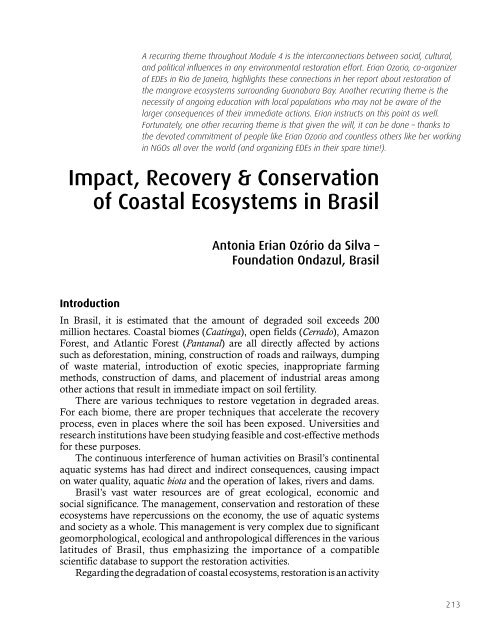Designing Ecological Habitats - Gaia Education
Designing Ecological Habitats - Gaia Education
Designing Ecological Habitats - Gaia Education
Create successful ePaper yourself
Turn your PDF publications into a flip-book with our unique Google optimized e-Paper software.
Impact, Recovery & Conservation<br />
of Coastal Ecosystems in Brasil<br />
Introduction<br />
A recurring theme throughout Module 4 is the interconnections between social, cultural,<br />
and political influences in any environmental restoration effort. Erian Ozorio, co-organizer<br />
of EDEs in Rio de Janeiro, highlights these connections in her report about restoration of<br />
the mangrove ecosystems surrounding Guanabara Bay. Another recurring theme is the<br />
necessity of ongoing education with local populations who may not be aware of the<br />
larger consequences of their immediate actions. Erian instructs on this point as well.<br />
Fortunately, one other recurring theme is that given the will, it can be done – thanks to<br />
the devoted commitment of people like Erian Ozorio and countless others like her working<br />
in NGOs all over the world (and organizing EDEs in their spare time!).<br />
Antonia Erian Ozório da Silva –<br />
Foundation Ondazul, Brasil<br />
In Brasil, it is estimated that the amount of degraded soil exceeds 200<br />
million hectares. Coastal biomes (Caatinga), open fields (Cerrado), Amazon<br />
Forest, and Atlantic Forest (Pantanal) are all directly affected by actions<br />
such as deforestation, mining, construction of roads and railways, dumping<br />
of waste material, introduction of exotic species, inappropriate farming<br />
methods, construction of dams, and placement of industrial areas among<br />
other actions that result in immediate impact on soil fertility.<br />
There are various techniques to restore vegetation in degraded areas.<br />
For each biome, there are proper techniques that accelerate the recovery<br />
process, even in places where the soil has been exposed. Universities and<br />
research institutions have been studying feasible and cost-effective methods<br />
for these purposes.<br />
The continuous interference of human activities on Brasil’s continental<br />
aquatic systems has had direct and indirect consequences, causing impact<br />
on water quality, aquatic biota and the operation of lakes, rivers and dams.<br />
Brasil’s vast water resources are of great ecological, economic and<br />
social significance. The management, conservation and restoration of these<br />
ecosystems have repercussions on the economy, the use of aquatic systems<br />
and society as a whole. This management is very complex due to significant<br />
geomorphological, ecological and anthropological differences in the various<br />
latitudes of Brasil, thus emphasizing the importance of a compatible<br />
scientific database to support the restoration activities.<br />
Regarding the degradation of coastal ecosystems, restoration is an activity<br />
213







